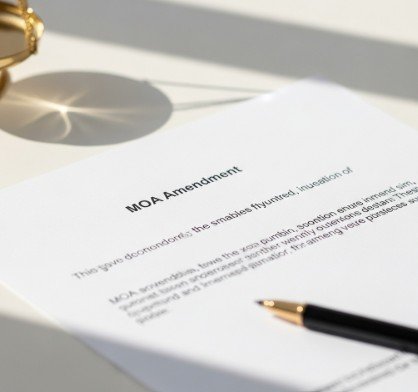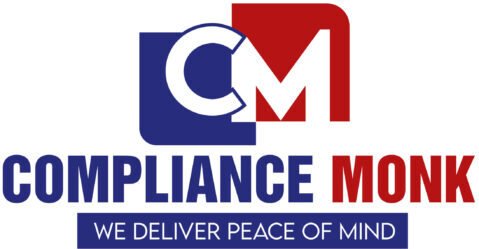
In the ever-evolving business landscape, companies often need to modify their Memorandum of Association (MOA) to align with new strategies, goals, or operational shifts. Since the MOA is a legal cornerstone defining a company’s objectives and scope, any changes must comply with the Companies Act, 2013.
Table of Contents
What is a Memorandum of Association (MOA)?
The MOA is the legal document that defines a company’s identity, operational scope, and shareholder relationships. It is drafted during incorporation and lays out key clauses governing the company’s activities.
The MOA contains several crucial clauses:
- Name Clause – Defines the official company name.
- Situation Clause – Specifies the registered office location.
- Object Clause – Outlines the business activities the company is permitted to undertake.
- Liability Clause – Establishes the liability of members (limited by shares or guarantee).
- Capital Clause – Details the company’s authorized capital and shareholding structure.
- Subscription Clause – Includes the initial subscribers who form the company.
MOA Amendment: What Does It Mean?
An MOA amendment refers to modifying any of the clauses mentioned above, except the Subscription Clause, under Section 13 of the Companies Act, 2013. This is often necessary when a company expands its operations, restructures, or shifts its strategic focus.
When Should a Company Amend Its MOA?
A company may need to alter its MOA in the following cases:
✅ Change of Name – Requires passing a special resolution and filing necessary approvals. If the name change involves a public or private limited company, no central government approval is needed, but for other entities, permission is required.
✅ Registered Office Relocation (Inter-State) – Companies shifting their registered office from one state to another must alter their MOA accordingly. This often happens for better business efficiency, expansion, or mergers. A special resolution and approval from the Registrar of Companies (ROC) of both states are mandatory.
✅ Modification of Object Clause – Companies evolving their business model or adding new services must amend the Object Clause. If the company has raised public funds, a special resolution, newspaper publication, and SEBI compliance are required.
✅ Altering the Liability Clause – Any modifications in the liability clause to limit directors’ liability require a resolution and must be filed with the ROC within 30 days.
✅ Changes to Capital Clause – Companies adjusting share capital due to mergers, stock consolidations, or cancellations must amend their Capital Clause via a resolution. The revised MOA must be filed within 30 days of approval.
✅ Increasing Authorized Capital – If a company needs to issue more shares, it must ensure its authorized capital allows for it. If not, the MOA must be updated accordingly.
Documents Required for MOA Amendment
To process an MOA amendment, a company must submit:
📌 Revised MOA – Reflecting the proposed changes.
📌 Certified Copy of Special Resolution – Approved at the Extraordinary General Meeting (EGM).
📌 Explanatory Statement – Justifying the modifications.
📌 EGM Notice – Informing members about the proposed changes.
📌 Form MGT-14 – Filed with the Registrar of Companies (ROC) for approval.
Step-by-Step Process for MOA Amendment
Amending an MOA follows a structured legal process under the Companies Act, 2013:
Step 1: Board Resolution
- The board of directors passes a resolution outlining the proposed MOA amendments and their justifications.
Step 2: Special Resolution Drafting
- A detailed special resolution is drafted, specifying the changes in relevant clauses (Name, Object, Capital, etc.).
Step 3: Notice for General Meeting
- A formal EGM notice is sent to shareholders, directors, and auditors at least 21 days in advance.
Step 4: Extraordinary General Meeting (EGM)
- The special resolution is presented, discussed, and voted upon. A 75% majority is required for approval.
Step 5: Filing with ROC
- Post-approval, Form MGT-14 is filed with the ROC within 30 days along with necessary documents.
Step 6: Registrar’s Approval & MOA Update
- The Registrar of Companies reviews and registers the amendment, making it legally effective.
Step 7: Internal Updates & Notifications
- Once approved, the company must update internal records, inform stakeholders, and update official documents.
Key Considerations for MOA Amendments
📌 Capital Clause Alteration – Can be done only if allowed under the Articles of Association (AOA).
📌 Liability Clause Change – Directors’ liability can be modified, but shareholders’ liability remains unchanged.
📌 Situation Clause Change – If relocating, the company must submit address proof within 30 days via Form INC-22.
📌 Companies Limited by Guarantee – Cannot extend profit-sharing rights to non-members.
📌 Old Companies Updating to New MOA Format – Businesses incorporated before Companies Act, 2013, may need to adopt a new MOA to align with modern legal frameworks.
Simplify Your MOA Amendment with Compliance Monk!
Amending an MOA involves multiple legal steps, strict timelines, and compliance requirements. At Compliance Monk, we take care of everything—from drafting resolutions to filing with the ROC—so you can focus on your business.
📞 Contact our experts today and make your MOA amendments stress-free!
FAQs on MOA Amendment
1. What is a Memorandum of Association (MOA)?
The MOA (Memorandum of Association) is a legal document that defines a company’s scope, objectives, and operational framework. It is prepared during incorporation and acts as the company’s charter.
2. Why does a company need to amend its MOA?
A company may need to amend its MOA due to changes in its name, registered office, business objectives, authorized capital, liability structure, or other key operational aspects.
3. Which clauses in the MOA can be amended?
All clauses except the Subscription Clause can be amended, including:
- Name Clause
- Situation Clause (Registered Office)
- Object Clause
- Liability Clause
- Capital Clause
4. What is the process for amending an MOA?
The process involves:
- Board resolution to approve the amendment.
- Special resolution passed at an Extraordinary General Meeting (EGM).
- Filing Form MGT-14 with the Registrar of Companies (ROC).
- Registrar’s approval and update of company records.
5. How long does the MOA amendment process take?
The timeline depends on the nature of the amendment and ROC processing time. Typically, it takes 30-45 days, subject to approvals.
6. Do all MOA amendments require shareholder approval?
Yes, a special resolution requiring at least 75% shareholder approval is necessary for most MOA amendments.
7. What are the documents required for an MOA amendment?
- Revised MOA with proposed changes.
- Certified copy of the special resolution.
- Explanatory statement detailing the amendment.
- EGM notice sent to members.
- Form MGT-14 for ROC filing.
8. Can a company change its name through an MOA amendment?
Yes, a company can change its name by passing a special resolution and updating its MOA. Central government approval may be required in certain cases.
9. How can a company change its registered office to another state?
A company must pass a special resolution, obtain approval from both state ROCs, and amend its Situation Clause in the MOA.
10. What happens after an MOA amendment is approved?
Once the ROC registers the amendment, the company must update its internal records, notify stakeholders, and reflect changes in official documents.
11. Can a company increase its authorized capital through an MOA amendment?
Yes, a company must amend its Capital Clause if it plans to raise its authorized capital to issue more shares.
12. What penalties apply for non-compliance with MOA amendment procedures?
Failure to comply with the amendment process, including delayed filings, can result in penalties under the Companies Act, 2013, and potential legal consequences.
